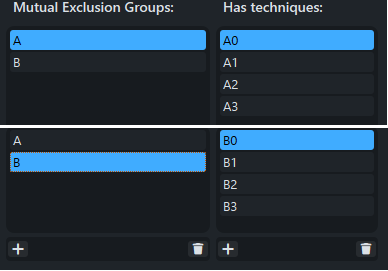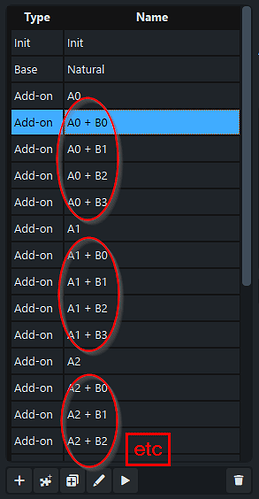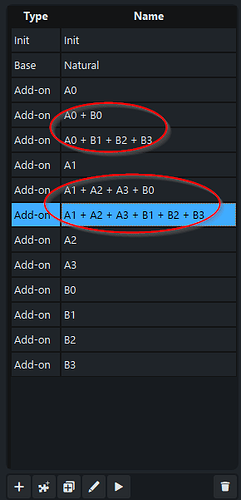Hi @benwiggy, thank you for the suggestion.
I was actually already using Mutual Exclusion Groups, one each for {A0,A1,A2,A3} and {B0,B1,B2,B3}, so that only one Playback Technique from each group would be active at any time. I’m sorry for not mentioning that initially.
If anyone would like to help me try and find a solution, I’ve set up a sample Dorico file (Boolean operators (NOT, AND, OR) for Playback Technique Combinations.dorico) with the eight above-mentioned custom Playback Techniques.
The Expression Map (named EM) has eight Technique Add-on Switches,

with Mutual Exclusion Groups for {A0,A1,A2,A3} and {B0,B1,B2,B3}.

This currently sets CC2 to {25,50,75,100} and CC3 to {25,50,75,100} for the A’s and B’s respectively (just to make it easy to see that they’re being activated correctly).
To achieve the objective stated in my first post, I can set up 16 new switches
and setting the CC4 values to {25,50,75,100} appropriately, I can get my desired results.
The question is whether this can be achieved more efficiently, by creating four new switches rather than 16.
As I type this, it feels like the answer to my question will be “no”. This attempt,
doesn’t work (well, A0 + B0 works but the others don’t). This seems to be because, for example, A1 + A2 + A3 + B1 + B2 + B3 is interpreted as
A1 AND A2 AND A3 AND B1 AND B2 AND B3
and with the Mutual Exclusion Groups for {A0,A1,A2,A3} and {B0,B1,B2,B3}, this is impossible. If I could have this interpreted as
(A1 OR A2 OR A3) AND (B1 OR B2 OR B3)
then I think I could get what I need.
Anyway, unless anyone has a further suggestion, I can live with implementing the 16 switches as a workaround. Thank you for reading. ![]()




